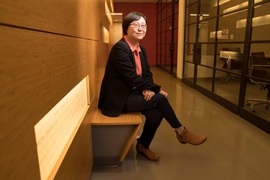Extreme temperatures make people less likely to pursue outdoor activities they would otherwise make part of their daily routine, a new study led by MIT researchers has confirmed.
The data-rich study, set in China, shows that when hourly temperatures reach 30 degrees Celsius (86 degrees Fahrenheit), people are 5 percent less likely to go to public parks, and when hourly temperatures hit 35 C (95 F), people are 13 percent less likely to go to those parks.
“We did observe adaptation,” says Siqi Zheng, an MIT professor and co-author of a new paper detailing the study’s findings. She adds: “Environmental hazards hurt the daily quality of life. Yes, people protect themselves [by limiting activity], but they lose the benefit of going out to enjoy themselves in nature, or meeting friends in parks.”
The research adds to our knowledge about the effects of a warming climate by quantifying the effects of hot temperatures on the activity of people within a given day — how they shift their activities from hotter to cooler time periods — and not just across longer periods of time.
“We found that if we take into account this within-day adaptation, extreme temperatures actually have a much larger effect on human activity than the previous daily or monthly estimations [indicate],” says Yichun Fan, an MIT doctoral candidate and another of the paper’s co-authors.
The paper, “Intraday Adaptation to Extreme Temperatures in Outdoor Activity,” is published this week in Nature Scientific Reports. The authors are Fan, a doctoral student in MIT’s Department of Urban Studies and Planning (DUSP); Jianghao Wang, a professor at the Chinese Academy of Sciences; Nick Obradovich, chief scientist at Project Regeneration; and Zheng, who is the STL Champion Professor of Urban and Real Estate Sustainability at MIT’s Center for Real Estate and DUSP, and faculty director of the MIT Center for Real Estate.
To conduct the study, the researchers used anonymized data for 900 million cellphone users in China in 2017, studying a total of 60 billion separate cellphone location queries per day available through the technology firm Tencent. With this data, the scholars also examined activity in 10,499 parks across the country, comparing useage totals across a range of conditions. And they obtained temperature data from about 2,000 weather stations in China.
Ultimately, as the scholars write in the paper, they were able to “document large and significant activity-depressing and activity-delaying effects” on park visits as a result of ultrahot temperatures.
“People have intraday adaptation patterns that hadn’t been documented in the previous literature,” Fan says. “These have important implications about people’s heat exposure and how future climate change will affect people’s activity and health.”
As Zheng points out, altered use of public spaces affects daily routines not only in terms of individual activity and exercise, but also in terms of social and community life.
“Extreme climates will reduce people’s opportunities to socialize in cities, or just watch kids playing basketball or soccer, which is not good,” she says. “We want people to have a wide-ranging urban life. There is a social cost to this adaptation.”
As the research indicates, people clearly adapt to temperature spikes. The data also show that evening use of parks increases on extremely hot days, but only after conditions have cooled down. While that seems like a beneficial adaptation to very hot weather, the scholars citing existing research suggest people may sleep less as a result of making this kind of change to their daily routines.
“Adaptation also has its own cost,” Fan says. “People significantly increased their nighttime outdoor activity, which means they delayed their nighttime, which will have a significant health implication, when you consider the potential sleep disruption.”
All told, the study provides data, and a method, for better characterizing the effects on climate change on human activity in detail.
“If we have more and more granular data about future climate scenarios, they support better predictions about these scenarios, reflecting people’s dynamic behaviors, and the health implications,” says Fan, whose doctoral research incorporates this work and other related studies on climate and urban activity.
The researchers also note that the research methods used in this study could be applied to additional future studies of many other aspects of urban life, including street-level retail activities, and other things with implications for economic activity, real estate, and urban planning.
“This relates to many other issues,” Zheng says.
Jianghao Wang received funding from the National Key Research and Development Program of China, the National Natural Science Foundation of China, and the Youth Innovation Promotion Association of the Chinese Academy of Sciences.











